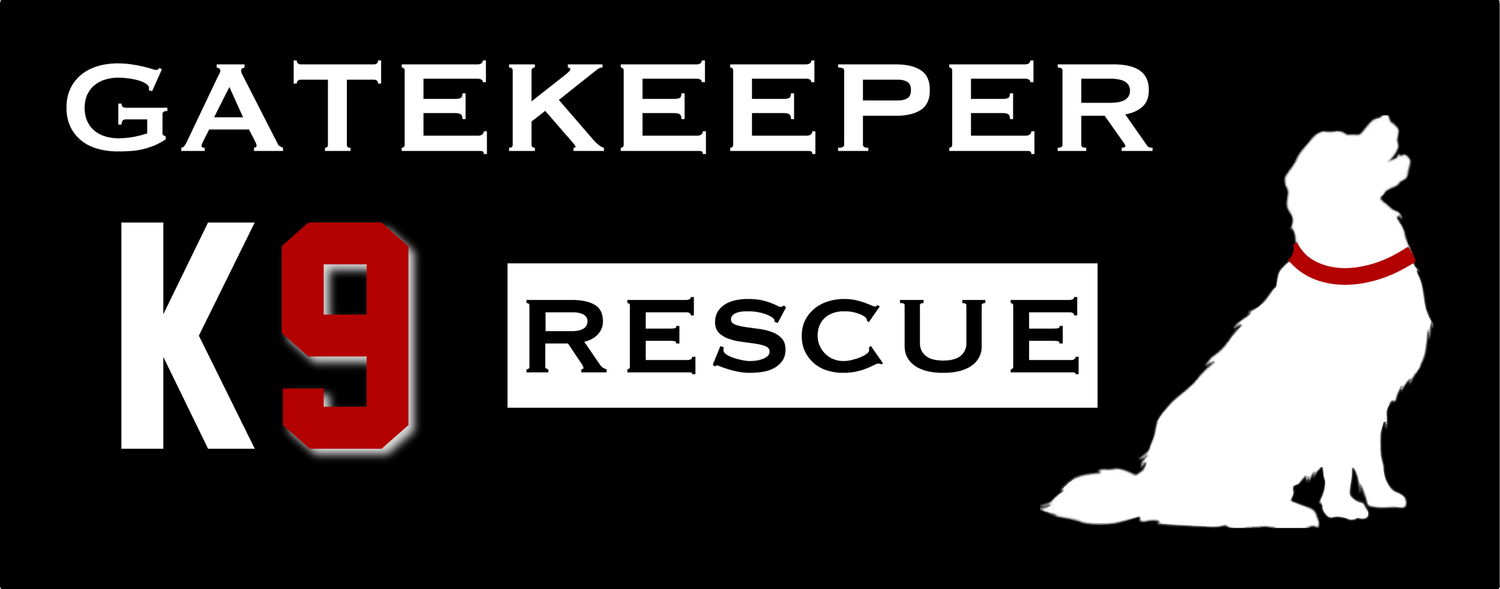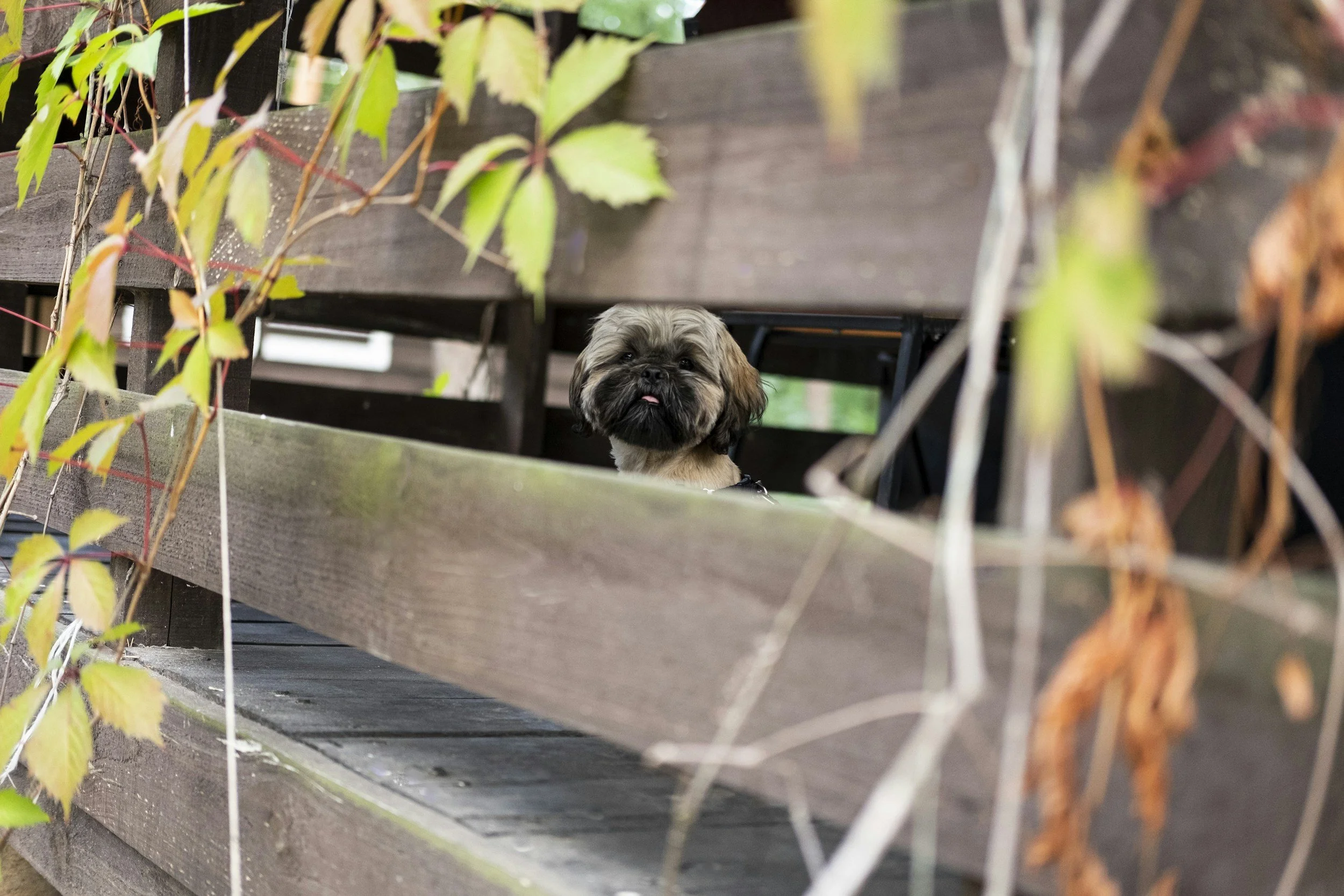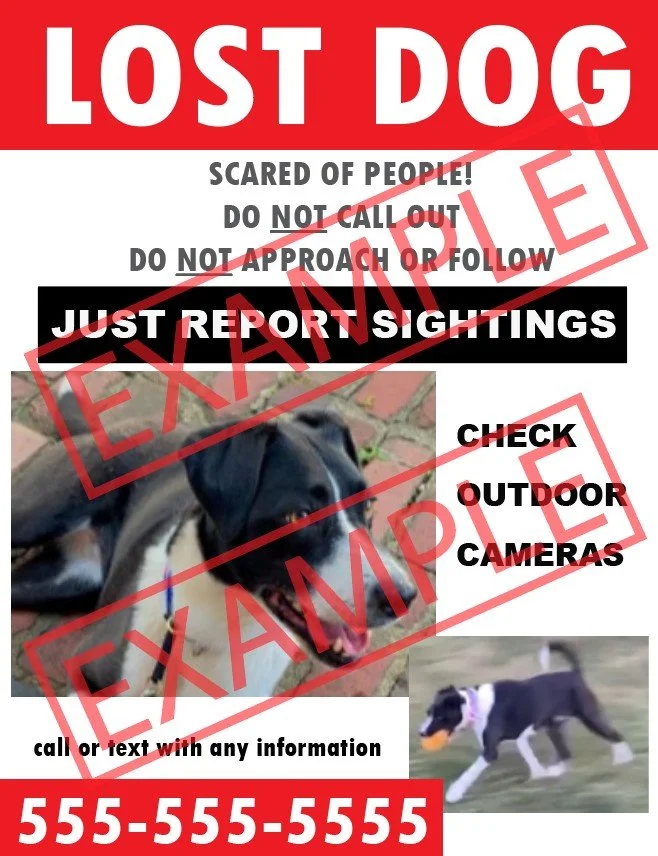My Dog is Lost - What Do I Do?
Read This First: The Critical Need-to-Knows of Lost Dog Search and Rescue
The Search and Rescue Process is Counterintuitive
Searching for and rescuing a lost dog is a very counterintuitive process. What may feel like the right thing to do is often the wrong thing.
The steps outlined on this page are part of a tried and true search and recovery process that works around the world. If the location of a dog is known and this process is carefully followed, chances of success are good.
Survival Mode: Understand a Lost Dog’s Mindset
When dogs become lost, they enter what is known as survival mode. In this state, they are guided entirely by instinct. Their senses are heightened and they perceive the world as a threat, especially people. Even if you’ve had your dog for years and share a deep bond, they may not recognize you as a safe presence.
Priorities of a dog in survival mode are, in this order:
Avoid humans at all costs (no exceptions, even family)
Water
Food
Shelter
Once back in a safe environment, dogs come out of survival mode and most return to their usual behavior with no long-term issues.
DO NOT Approach, Follow, or Call Out to a Lost Dog
If approached, followed, or startled (from yells, whistles, etc.), a lost dog in survival mode will flee, making rescue more complicated and dangerous.
This includes physically searching for a lost dog. They will hear you coming long before you reach them and run.
Lost dog rescue involves getting a dog to stay in an area where they can be rescued, not pushing them away.
Provide Food and Water
Lost dogs need food and water for survival. And as long as they are not scared away, finding food and water will keep them coming back to a location where they can hopefully be rescued.
What to Do If Your Dog is Lost
Immediately Upon Realizing Your Dog is Lost
Jump to Guides for Specific Lost Dog Scenarios
If You Think Your Dog Should/Could be In Your House
Look:
In closets, cabinets, bathrooms, corners, bathtubs, laundry baskets, crawl spaces, attics, and basements
Under furniture, beds, blankets, and piles of clothes
Behind curtains, furniture, and other objects
Check thoroughly inside. Dogs can hide in surprising places when they are frightened.
Keep all doors and windows securely closed during your search to prevent escape.
If You Believe/Know Your Dog Has Escaped
Disable any invisible or wireless fence.
Check your yard thoroughly, including:
Under decks, porches, vehicles
Inside cars, sheds, garages, and barns
Check fencing for possible escape points, through gaps, underneath, or over the fence.
Thoroughly and methodically search around landscaping and wooded areas that border the property. Check:
Behind trees, shrubs, large rocks, and fences
Under bushes, vines, and low-hanging branches
Within hedges or piles of brush or leaves
Anywhere the dog could fit or blend into - most dogs are such good hiders that you could practically be on top of them and not realize it
If you can’t find your dog near the point of escape, walk the neighborhood slowly and calmly with a leash, harness, and high-value treats. Avoid shouting your dog’s name.
If You See Your Dog
Do not approach.
Sit or lie down at a distance, facing sideways, and speak softly.
Let them come to you at their own pace. Sudden movements or excitement could cause them to bolt.
Try tossing treats gently across the ground in your dog’s direction as long as it does not appear to frighten them.
Wait patiently. This process could take quite a while.
Slowly reach for your dog when they are calm and within a few inches (they should be practically on top of you before you attempt to get them).
Prepare Your Property
If you don’t find your dog immediately, make your home a welcoming place to return to. Dogs typically return to or nearby the point of escape.
After dark:
Grill or smoke strong-smelling meat to create a scent trail.
Turn off exterior lights to reduce their fear of being exposed.
Place the following outside near the area of escape:
Your dog’s crate, blanket, or toys
Water and high-value, aromatic food (e.g., rotisserie chicken, ground beef, grilled hot dogs)
Position a trail camera on the food to monitor whether your dog returns.
If you don’t have a trail camera, spread flour or cornstarch around the food area to check for paw prints. Replenish food as needed, at least daily.
If your dog eats multiple times but does not approach the house, they may need to be trapped in the yard. If you are at this point with your dog, we may be able to help. Please submit a Request for Help.
If Lost from a Car Accident or Hit by Car
Avoid calling for your dog, or searching nearby woods. Allow your dog to approach when they’re ready.
If possible, remain at the accident site with a familiar car. Leave car doors open if possible.
If you must leave, position a trail camera on the food to monitor whether your dog returns. If you don’t have a trail camera, spread flour or cornstarch around the food area to check for paw prints. Replenish food as needed, at least daily.
If your dog returns to the location of the accident and you are there:
Sit or lie down at a distance, facing sideways, and speak softly.
Let them come to you at their own pace. Sudden movements or excitement could cause them to bolt.
Try tossing treats gently across the ground in your dog’s direction as long as it does not appear to frighten them.
Wait patiently. This process could take quite a while.
Slowly reach for your dog when they are calm and within a few inches (they should be practically on top of you before you attempt to get them).
If you know that your dog has returned to the accident location but you can’t wait there for them, or they will not approach you, continue to provide food and water. We may be able to help. Please submit a Request for Help.
Dogs involved in car accidents are often extremely frightened and hide nearby.
Place food and water in the direction they fled, away from roads.
If Escaped from a Car or Lost in a Park, Trail, or Campground
Dogs who run off from cars, at parks, during hikes, or on camping trips will most likely return to the car, trailhead, or campsite.
It does not matter if it is a new location that your dog is unfamiliar with.
Don’t leave personal items and walk away.
Stay put and wait patiently and quietly. Your presence is the best chance of reuniting with your dog.
If you are waiting in a car, leave car doors open if possible.
Don’t tell others in the area or online that your dog is lost - this will cause people to search for your dog and scare them away. Only spread the word if it has been more than 24 hours.
Give your dog time to do what they instinctually know to do. Most dogs return when darkness falls or within 24 hours.
Within 24-48 Hours after Your Dog Becomes Lost
Searching for Your Dog
Your first instinct will be to go search for your dog. Counterintuitively, this is an action to avoid. We understand this is one of the most difficult parts of the process to adhere to. But searching for your dog can easily make the situation worse.
Physical searches are likely to make your dog feel threatened and even more frightened. This will cause your dog to move farther away, making it more difficult to locate and rescue them.
The best use of your time at this point is to focus on raising awareness that your dog is lost (see next section).
Exceptions
Physically searching for your dog is encouraged ONLY in these exceptional circumstances:
Your dog has significant mobility issues, such as debilitating arthritis
They are elderly and have mental health issues such as dementia or confusion
When they got loose they were wearing a leash (the leash could get tangled on something and they may get stuck somewhere)
If your dog is in one of these situations, you must search carefully and methodically; do not walk around aimlessly.
Supplies to bring on your search:
A bright flashlight so you can check in dark spots, even in the daylight (the flashlight on your phone will not be enough)
Utility knife to cut through a leash/collar/harness in case the dog is stuck
Water for yourself and the dog
Pruning shears and/or a small saw to cut branches
Leash and high value treats/food
First try to identify the direction your dog went, and then the path your dog traveled. Dogs tend to choose the path of least resistance but avoid crossing through open areas, preferring to hug edges like fences or treelines. Look for trails, treelines, walls, fences, railroad tracks, ditches, farm/tractor roads, and edges of fields.
Slowly and very quietly walk the path you believe your dog most likely traveled.
A lost, scared dog hiding in the woods in the wintertime. Imagine how difficult it would be to find her when everything was grown over in the spring or summer.
As you walk, look down to see if you can spot dog tracks and keep an eye out for the color of any leash/harness/collar your dog was wearing.
Listen for barking or sounds of distress. These may be more likely at dusk or after dark.
If they are found, dogs in these situations are usually hiding close to their path of travel.
Methodically search within about 20 feet of this path, keeping track of each location you go.
Slowly and quietly search one side of a path going out and the other side coming back. Tie strips of cloth/ribbon on trees as you go to mark locations already searched.
Thoroughly check hiding spots such as patches of brush, low-hanging branches, vines, debris, and open buildings or structures. This will be a time consuming, intensive process.
It is very easy to overlook a hiding dog, especially because they often naturally blend in with the surroundings and remain still and silent. If a dog in this situation is found, it is usually in a spot that has already been checked multiple times.
Dogs often travel farther than you think, including blind and disabled dogs. Even if you feel you’ve gone quite far, continue to search.
Raise Awareness that Your Dog is Lost
Raising public awareness is one of the most effective tools for bringing a dog home.
Report your dog lost to Local Dog Control Services/Law Enforcement
Make a Flyer
One way to make a flyer for free is Canva.
Use bright colors and large "LOST DOG" text
Include clear photos, your phone number, and “DO NOT CHASE/FOLLOW”
Ask people to check outdoor cameras
Do not offer a reward (it may cause people to chase your dog and scare them away)
Distribute Flyers
Print several hundred color copies of your flyer to start. One option is Syracuse Printing Center, which offers affordable rates.
Use staples or weatherproof tape to hang flyers. In neighborhoods without poles, distribute door-to-door.
Post flyers within a mile radius of the point of escape on/at:
Telephone poles at intersections (angle toward oncoming traffic)
Local businesses, community centers, parks, gas stations, coffee shops (ask if you can hang in windows/on bulletin boards)
Dog parks, veterinary offices, trailheads
Post on Social Media
Share your flyer and dog’s story on:
Facebook Groups Lost & Found Pets of CNY, LOST AND FOUND PETS OF CNY
Important:
Do not post specific sighting locations/details (this will drive well-intentioned people to the location and scare your dog away)
Do not encourage others to look for your dog
DO NOT offer a reward. This will cause people to try to catch your dog, which will scare them and push them farther away.
Clearly state: “Do not chase, call out, or follow. Just report sightings by calling or texting this number immediately.”
Microchip and Shelter Check
Make sure the contact information associated with your dog’s microchip is up to date.
Know how the microchip company will contact you if your dog is found. If it is by email, regularly check for messages.
Contact nearby shelters daily. Provide a detailed description and recent photos.
B&R Bunkhouse (City of Syracuse): 315-546-4242
CNY SPCA (Onondaga County): 315-454-4479
Camillus Town Kennel (Onondaga County): 315-488-1234
Finger Lakes Dog Protection Agency (Cayuga County): 315-253-4367
Finger Lakes SPCA of CNY (Cayuga County): 315-253-5841
Cortland County SPCA (Cortland County): 607-753-9386
Country Acres Animal Shelter (Cortland County): 607-749-2734
Wanderer’s Rest Humane Association (Madison County): 315-697-2796
Humane Society of Rome (Oneida County): 315-336-7070
Anita’s Stevens Swan Humane Society (Oneida County): 888-306-1878
Oswego City Animal Shelter (Oswego County): 315-343-1803
Palermo Town Kennel (Oswego County): 315-593-2333 (ext. 226)
Call Highway Departments/Public Works/Transportation
When animal remains are found on a roadway, the highway department, department of public works, or department of transportation will be called to pick them up. If the animal is a dog, they will not scan for a microchip or notify local dog control services, and may not even keep records of the call or who responded. Contact these departments to see if they have received any calls and if you can get more information about the animal or who responded to the call.
How to Manage Sightings
Be Available 24/7
Make sure you can be reached on your cell phone 24 hours a day
Keep a log of sightings with names and contact information from callers in case you need to follow up.
What to Ask Someone Who Reports a Sighting
Ask the following questions and record answers in a log of sightings. When asking questions, do not provide information about your dog or anything they may be wearing. You do not want to give people ideas about what they might have seen.
Can you describe the dog you saw? (colors/markings/size/male or female/collar or harness/color of collar or harness)
When did you see the dog?
Where did you see the dog? (ask for specific address/location/landmark)
Was the dog in the road, on a sidewalk, in a parking lot, in a yard (front or back)?
What was the dog doing when you saw them?
What direction was the dog coming from? What direction were they moving in?
Keep in mind that every lost dog search has sightings of dogs that aren’t yours, or reported sightings of animals that are not even dogs.
BEWARE OF SCAM ARTISTS
Unfortunately, there are people who prey on owners of lost dogs by sending them messages that they have their dog and asking for money. If you are contacted by someone who says they have your dog, ask them to send you a picture. If they cannot produce a picture, they are probably trying to scam you.
DO NOT Broadcast Details about Sightings! DO NOT Post Sightings on Social Media!
If you receive a sighting that you believe to be your dog, keep the information to yourself. Telling others about the sighting is likely to drive people to the location to physically search for your dog, which will scare your dog away. Information about sightings should only be shared with a trapper.
At The Location of a Sighting
What To Do:
Leave food and water.
Position a trail camera on the food to monitor whether your dog returns.
If you don’t have a trail camera, spread flour or cornstarch around the food area to check for paw prints.
Replenish food as needed, at least daily.
If not there already, add flyers in all directions around the sighting location.
DO NOT:
Search for your dog
Call out or yell your dog’s name
Wait at the sighting location
Visit the sighting location after dark
If You See Your Dog:
Do not approach directly
Sit or lie down at a distance, facing sideways, and speak softly.
Let them come to you at their own pace. Sudden movements or excitement could cause them to bolt.
Try tossing treats gently across the ground in your dog’s direction as long as it does not appear to frighten them.
Wait patiently. This process could take quite a while.
Slowly reach for your dog when they are calm and within a few inches (they should be practically on top of you before you attempt to get them).
48+ Hours with No Sightings of Your Dog
If there have been no sightings within 48 hours of your dog becoming lost, continue to raise awareness.
Flyering is the best use of your time.
If your dog’s location is still unknown, expand the flyer radius by one mile. Keep expanding by one mile every several days without any reported sightings.
If you are getting little to no information about your dog’s location after flyering, you may consider a mass mailing through the post office’s Every Door Direct Mail program.










